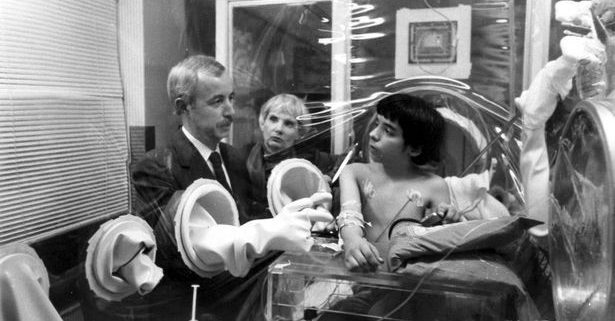News
State targets ‘bubble boy’ syndrome
 Young David Vetter, who died from severe combined immunodeficiency (SCID) in the 1990s. (Photo: Biotechnology and Society)
Young David Vetter, who died from severe combined immunodeficiency (SCID) in the 1990s. (Photo: Biotechnology and Society)California’s stem cell agency is ready to award $20 million on Thursday to a UCLA researcher to assist in his 30-year search for a widely available cure for what has come to be known as the “bubble boy” syndrome– severe combined immunodeficiency (SCID).
The California scientist is Donald Kohn, of the Broad Stem Cell Research Center at UCLA, who said Tuesday that 30 out of 30 babies have already been cured using his type of therapy. Kohn said that the research involving the extremely rare disease could lead to progress in treating other afflictions ranging from sickle cell disease to cancer.
The progress in treating the “bubble boy” disease is much changed from decades ago when the case of David Vetter captured the nation’s attention as the boy who was “born into a world he could not touch.” He ultimately died at the age of 12.
Kohn’s proposal for an early stage clinical trial would be co-funded with $8.9 million and would test a stem cell and gene product known as OTL-101. It could replace what the stem cell agency said were the “suboptimal,” current treatments for Adenosine Deaminase Severe Combined Immunodeficiency.
The affliction is extremely rare and occurs in less than one in 100,000 births worldwide, according to Wikipedia. Without treatment, children can die before the age of two.
The agency’s application review summary said that reviewers were “highly enthusiastic” about Kohn’s proposal during their closed-door session last month. The summary said that reviewers, who are from out-of-state and do not publicly disclose their economic interests, “applauded the move to a cryopreserved product that will allow improved patient access to the therapy.” They also noted that the costs of the trial are “exceedingly high.”
“This study is being done at the UCLA Broad Stem Cell Research Center in partnership with Orchard Therapeutics Ltd., who have licensed this stem cell gene therapeutic from UCLA and University College London, UK. The general approach of stem cell gene therapy was first done for ADA SCID, which is a highly favorable disease for this treatment. Findings and advances made for this disorder are being applied to many other inherited diseases, such as Sickle Cell Disease, other Primary Immune Deficiencies, Storage and Metabolic Diseases, as well as HIV/AIDS, cancer and leukemia.”
—
Ed’s Note: David Jensen is a retired newsman who has followed the affairs of the $3 billion California stem cell agency since 2005 via his blog, the California Stem Cell Report, where this story first appeared. He has published more than 4,000 items on California stem cell matters in the past 11 years.
Want to see more stories like this? Sign up for The Roundup, the free daily newsletter about California politics from the editors of Capitol Weekly. Stay up to date on the news you need to know.
Sign up below, then look for a confirmation email in your inbox.

Leave a Reply